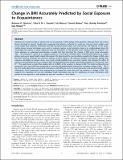Change in BMI Accurately Predicted by Social Exposure to Acquaintances
Author(s)
Oloritun, Rahman O.; Ouarda, Taha B. M. J.; Moturu, Sai T.; Madan, Anmol; Khayal, Inas; Pentland, Alex Paul; ... Show more Show less
DownloadOloritun-2013-Change in BMI Accura.pdf (318.8Kb)
PUBLISHER_CC
Publisher with Creative Commons License
Creative Commons Attribution
Terms of use
Metadata
Show full item recordAbstract
Research has mostly focused on obesity and not on processes of BMI change more generally, although these may be key factors that lead to obesity. Studies have suggested that obesity is affected by social ties. However these studies used survey based data collection techniques that may be biased toward select only close friends and relatives. In this study, mobile phone sensing techniques were used to routinely capture social interaction data in an undergraduate dorm. By automating the capture of social interaction data, the limitations of self-reported social exposure data are avoided. This study attempts to understand and develop a model that best describes the change in BMI using social interaction data.
We evaluated a cohort of 42 college students in a co-located university dorm, automatically captured via mobile phones and survey based health-related information. We determined the most predictive variables for change in BMI using the least absolute shrinkage and selection operator (LASSO) method. The selected variables, with gender, healthy diet category, and ability to manage stress, were used to build multiple linear regression models that estimate the effect of exposure and individual factors on change in BMI. We identified the best model using Akaike Information Criterion (AIC) and R[superscript 2].
This study found a model that explains 68% (p<0.0001) of the variation in change in BMI. The model combined social interaction data, especially from acquaintances, and personal health-related information to explain change in BMI.
This is the first study taking into account both interactions with different levels of social interaction and personal health-related information. Social interactions with acquaintances accounted for more than half the variation in change in BMI. This suggests the importance of not only individual health information but also the significance of social interactions with people we are exposed to, even people we may not consider as close friends.
Date issued
2013-11Department
Massachusetts Institute of Technology. Media Laboratory; Program in Media Arts and Sciences (Massachusetts Institute of Technology)Journal
PLoS ONE
Publisher
Public Library of Science
Citation
Oloritun, Rahman O., Taha B. M. J. Ouarda, Sai Moturu, Anmol Madan, Alex (Sandy) Pentland, and Inas Khayal. “Change in BMI Accurately Predicted by Social Exposure to Acquaintances.” Edited by Manlio Vinciguerra. PLoS ONE 8, no. 11 (November 20, 2013): e79238.
Version: Final published version
ISSN
1932-6203
